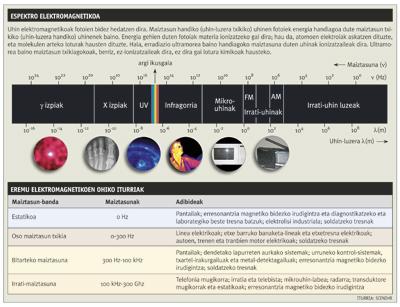Pending final results
2010/01/01 Galarraga Aiestaran, Ana - Elhuyar Zientzia Iturria: Elhuyar aldizkaria

WHO created in 1996 the International Project of Electromagnetic Fields to investigate the health risks of electromagnetic field emitting technologies. Within the project, numerous international investigations have been coordinated and the investigations carried out are periodically reviewed. Based on the results obtained so far, the main conclusion of the WHO is that the level of radiation received by people in general is “not dangerous to health” and there is no reason to modify the safety limits established in the legislation.
However, WHO considers that many aspects remain to be clarified. Among other things, it recognizes that the biophysical mechanisms that cause electromagnetic radiations in cells in different frequency bands are not sufficiently known. The WHO is also concerned about the effects mobile may have on children, as well as the relationship between mobile phones and tumor formation according to studies. Thus, in a research agenda, it has prioritized the investigations to be carried out, some of which are already underway.
Although MOE is the world reference, in Europe, SCENIHR is also responsible for the topic. SCENIHR is the Scientific Committee of the European Union of Emerging and Newly Identified Health Risks, and in 2007 published a comprehensive study.
Specifically, he analyzed the four frequency bands of the electromagnetic spectrum: the radio frequency emitted by mobile phones and microwave ovens (100 kHz-300 GHz); the intermediate frequency emitted by computer screens (300 Hz-100 kHz); the very low frequency of electric lines and other electrical networks (0-300 Hz); and finally, static electromagnetic radiation (0 Hz). This is due, for example, to magnetic resonance devices.
According to SCENIHR, it is known that if the electromagnetic field is "large enough", biophysical mechanisms occur that can affect health. Includes examples: At frequencies above 100 kHz (for example, radio waves), the induced current causes the "excitation of nerves and muscles", while at even higher frequencies occurs the "heating of the tissues". In both cases, there are acute effects on which standards are established that limit exposure.
In order to ensure that the values established by the norms and the minors of them are not dangerous, and to analyze if there are biophysical mechanisms and their consequences, the studies carried out in each frequency band were reviewed. In fact, it took into account the publications made in scientific journals written in English, of three types: epidemiological studies, in vivo and in vitro studies.
In general, the final conclusion coincides with that indicated by WHO, that is, at the usual exposure levels and in those frequency bands there is no evidence that the technologies emitting electromagnetic radiation cause damage.

However, like WHO, SCENIHR believes that research needs to be deepened and priorities defined last year in three lines are defined. On the one hand, the aim of the radio frequency band is to know the impact on the health of wireless communication systems and through which mechanisms they act. On the other hand, in the band of intermediate frequencies want to investigate their health effects. Finally, in the band of very low frequency, they seek to clarify the relationship between this type of radiation and diseases of nervous degeneration. These investigations are already being carried out.
INTERPHONE, only missing effects
While WHO and SCENIHR studies are underway, the INTERPHONE projects are already completed. Specially designed to analyze the relationship between the long-term use of mobile phones and cancer, it has lasted ten years.
Besides the long one, the project is broad, with the participation of thirteen countries: Australia, Canada, Denmark, Finland, France, Germany, Israel, Italy, Japan, New Zealand, Norway, Sweden and Great Britain. Some countries have already published their results and are available on the Internet. They report that the final results and conclusions will be published shortly, so it is possible that this article is published for when it is written and reached to the reader.
In any case, the conclusions of the research published so far reinforce what has been said by the main health organizations, which affirm that there is no relationship between brain cancer and mobile phones.
Specifically, 23 research groups have analyzed their potential impact on brain cancer and a single group has found a weak relationship. In fact, according to Hardell's Swedish group, the risk of suffering from mental tumors appears to increase with mobile phone use. In all cases, they were benign tumors, which did not find malignant tumors.

However, there is a difference between what is indicated by INTERPHONE and MOE and SCENIHR. Precisely, on the possible influence of electromagnetic fields in children, WHO and SCENIHR show great prudence in considering that there are indications that they can be harmful. They indicate that more and as soon as possible should be investigated. Meanwhile, it is recommended to "reduce" the use of mobile phones and other similar technologies.
However, in the opinion of INTERPHONE, there is no reason to recommend it, since at the moment research does not show that it affects children more or less seriously than adults.
Consensus and debate
As among organizations, among experts, there are conflicting opinions about the effects they can have on children. Josep Ferris i Tortajada, a pediatrician specialising in oncology, is the director of the PEHSU Unit (Pediatric Environmental Health Speciality Units) in Murcia, investigates the influence of environmental factors on children. Undoubtedly, radiofrequency radiation "is more dangerous" for children than for adults.
Of the same opinion is Miguel Sancho, biophysicist of the Complutense University of Madrid. Among the causes is the fact that the nervous system of children is still unmatured, so the incidence on them is higher. Because your brain is more conductive, the waves cross the skull more easily... In addition, they extend to electromagnetic radiations before which they are now adult, so they are received for longer.
However, biochemist Juan Manuel Garc a, head of magnetic resonance at Hospital Nuestra Se ora del Rosario in Madrid, considers that the concern is excessive. He adds that in childhood cancer many other factors should be investigated and, with some irony, he asks: "Investigating, why not investigate the relationship between the consumption of ultra-modern bakeries and hyperactivity and lack of intelligence, for example? ". He believes that in issues related to children, excessive panic often occurs.

Between alarmism and relaxation, Ferris has an intermediate position: "Logically, technological-industrial progress produces benefits and losses. The problem is that industrialization advances at full speed and takes a long time to know its impact on health. That is why it is so necessary to maintain the principle of caution."
Sancho and Garc claim the health benefits of technologies based on electromagnetic fields. In this way, Garc explains that spectroscopic techniques so used in medicine, biochemistry and biology are based on the interaction of electromagnetic radiation with matter.
Sancho highlights its uses in diagnosis and therapy. In fact, although in other frequencies, from x-rays to computerized axial tomography or electromagnetic resonance, they are widely used in diagnosis. Low-frequency pulses are also used in therapy, for example, low-frequency pulses are used to form the bones. And they are investigating new applications.
However, before the results of these investigations arrive those of INTERPHONE. To them are now experts, institutions and individuals concerned about the subject. We will see what reactions produce the conclusions of the study.

Gai honi buruzko eduki gehiago
Elhuyarrek garatutako teknologia






